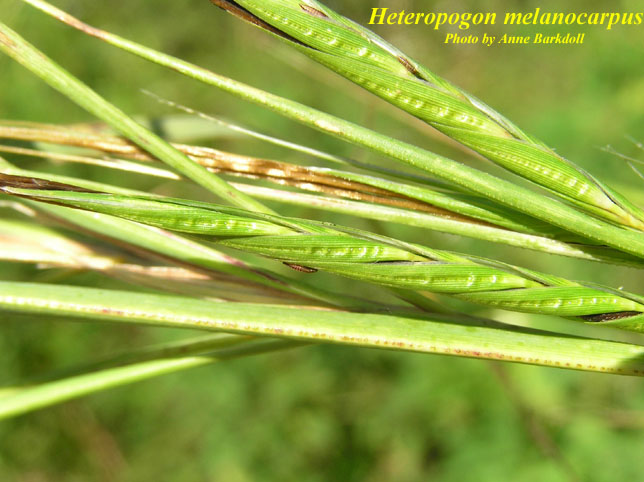Heteropogon melanocarpus


Common Name: sweet tanglehead
Family: Poaceae
Common Synonyms: Andropogon melanocarpus
USDA Hardiness Zone: NA
Growth Habit: Annual grass
Origin: Mexico, Central and South America
FISC Category: -
FDACS Listed Noxious Weed: No
Introduction Date: Earliest Florida specimen vouchered in 1891
IFAS Assessment:

Plant annual. Culms 50-200 cm, often with prop roots, freely branching above the base. Sheaths glabrous, with a row of glandular depressions along the keel; ligules 2-4 mm, erose to lacerate; blades 30-50 cm long, 3-12 mm wide, usually folded, abaxial surfaces with dark glandular depressions along the keel. Rames 2.5-6.5 cm. Sessile spikelets 8-11.5 mm, dark brown, awned; calluses about 3 mm; awns 10-15 cm and twisted, coiling together; pedicellate spikelets 16-21 mm, unawned; lower glume midveins glandular, pitted.
Roadsides, firelines, field edges and sandhills
Spreads with wind and vehicle traffic. Leaves smell of citrus/citronella oil. Outcompetes other groundcover in sunny, upland ecosystems.

NA
IFAS, UF. 2017. Assessment of Non-Native Plants in Florida's Natural Areas. Heteropogon melanocarpus. https://assessment.ifas.ufl.edu/assessments/heteropogon-melanocarpus/ Accessed March 27, 2022.
Wunderlin, R. P., and B. F. Hansen. 2008. Atlas of Florida Vascular Plants (http://florida.plantatlas.usf.edu/).[S. M. Landry and K. N. Campbell (application development), Florida Center for Community Design and Research.] Institute for Systematic Botany, University of South Florida, Tampa.
Boufford, D. E. Fumaria. In: Flora of North America Editorial Committee, eds. 1993+. Flora of North America North of Mexico [Online]. 22+ vols. New York and Oxford. Vol. 25. http://floranorthamerica.org/Heteropogon_melanocarpus. Accessed [2 August 2022].
